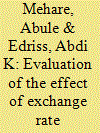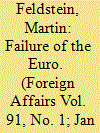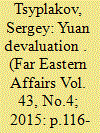| Srl | Item |
| 1 |
ID:
193619


|
|
|
|
|
| Summary/Abstract |
By looking at the September 1949 devaluation dilemma faced by the governments of Pakistan and India, this article argues that it was an early episode of divergence between them following partition. The reasons why Pakistan did not devalue when India did so have remained largely obscured in the historiography. Deeply contested, the decision was a determining event through which the state staked its claim for economic sovereignty, internally and externally. It led to a 17-month-long official trade deadlock, especially in the eastern region of partitioned Bengal. It ended when the two governments established an exchange ratio for the two rupees, no longer at par with each other. This interactive delinking of currencies was symptomatic of the improvisational decoupling of the colonial subcontinent’s post-colonial states. In tracing its trajectory, this article contributes to the inconsiderable literature on why devaluation did not happen in Pakistan, revises the rationale offered, and presents the event as a contingent exercise in economic decolonization, generative of a post-colonial sovereign difference.
|
|
|
|
|
|
|
|
|
|
|
|
|
|
|
|
| 2 |
ID:
122454


|
|
|
|
|
| Publication |
2013.
|
| Summary/Abstract |
Research was conducted to find out the effects of exchange rate variability, terms of trade, competitiveness and gross domestic product on the dominant export crop of Ethiopia, coffee. This study employs annual time series data (1992-2010) and uses the autoregressive distributive lag (ARDL) model augmented by the Wald test. The results reveal that exchange rate variability has a negative effect on the export of coffee in the short run, but is insignificant in the long run. This implies that, over time, exchange rate changes in the country have been favouring the export performance of coffee. Regardless of exchange rate variability, the competitiveness of the country, explained by real effective exchange rates, improved, but the price of coffee did not increase relative to the price of imports, which has resulted in deteriorating terms of trade. To improve the worsening terms of trade and benefit from policy changes, export diversification and value addition are possible solutions the country should focus on.
|
|
|
|
|
|
|
|
|
|
|
|
|
|
|
|
| 3 |
ID:
108953


|
|
|
| 4 |
ID:
142950


|
|
|